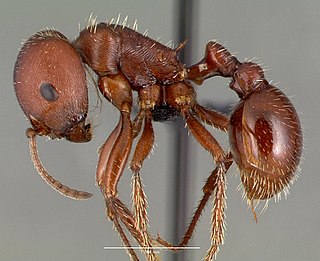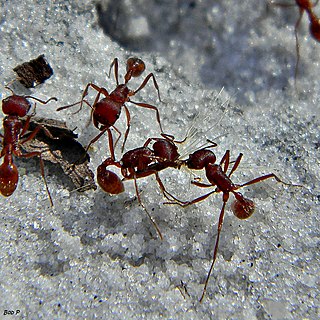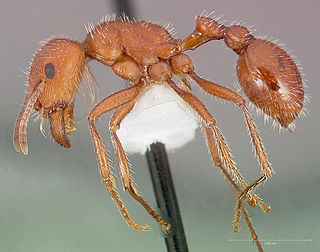
Ants are eusocial insects of the family Formicidae and, along with the related wasps and bees, belong to the order Hymenoptera. Ants evolved from vespoid wasp ancestors in the Cretaceous period. More than 13,800 of an estimated total of 22,000 species have been classified. They are easily identified by their geniculate (elbowed) antennae and the distinctive node-like structure that forms their slender waists.

Pogonomyrmex barbatus is a species of harvester ant from the genus Pogonomyrmex. Its common names include red ant and red harvester ant. These large ants prefer arid chaparral habitats and are native to the Southwestern United States. Nests are made underground in exposed areas. Their diets consist primarily of seeds, and they consequently participate in myrmecochory, an ant-plant interaction through which the ants gain nutrients and the plants benefit through seed dispersal. Red harvester ants are often mistaken for fire ants, but are not closely related to any fire ant species, native or introduced.

Pogonomyrmex is a genus of harvester ants, occurring primarily in the deserts of North, Central, and South America, with a single endemic species from Haiti.

Carpenter ants are large ants indigenous to many forested parts of the world.

Harvester ant, also known as harvesting ant, is a common name for any of the species or genera of ants that collect seeds, or mushrooms as in the case of Euprenolepis procera, which are stored in the nest in communal chambers called granaries. They are also referred to as agricultural ants. Seed harvesting by some desert ants is an adaptation to the lack of typical ant resources such as prey or honeydew from hemipterans. Harvester ants increase seed dispersal and protection, and provide nutrients that increase seedling survival of the desert plants. In addition, ants provide soil aeration through the creation of galleries and chambers, mix deep and upper layers of soil, and incorporate organic refuse into the soil.

Iridomyrmex is a genus of ants called rainbow ants first described by Austrian entomologist Gustav Mayr in 1862. He placed the genus in the subfamily Dolichoderinae of the family Formicidae. It has 79 described species and five fossil species. Most of these ants are native to Australia; others are found in Asia and Oceania, and they have been introduced to Brazil, New Zealand, and the United Arab Emirates. Fossil species are known from China, France, and the United States.

Aphaenogaster is a genus of myrmicine ants. About 200 species have been described, including 18 fossil species. They occur worldwide except in South America south of Colombia, sub-Saharan Africa, and Antarctica.

Pogonomyrmex maricopa, the Maricopa harvester ant, is one of the most common species of harvester ant found in the U.S. state of Arizona, but it is also known from California, Colorado, New Mexico, Nevada, Texas and Utah, and the Mexican states of Baja California, Chihuahua, Sinaloa and Sonora. Its venom is believed to be the most toxic insect venom in the world.

Pogonomyrmex californicus, or California harvester ant, is a species of ant in the subfamily Myrmicinae. It is native to North America, where it occurs in the southwestern United States and northern Mexico. It is best known as the ant that is sent out for Uncle Milton's Ant Farm.

Pogonomyrmex occidentalis, or the western harvester ant, is a species of ant that inhabits the deserts and arid grasslands of the American West at or below 6,300 feet (1,900 m). Like other harvester ants in the genus Pogonomyrmex, it is so called because of its habit of collecting edible seeds and other food items. The specific epithet "occidentalis", meaning "of the west", refers to the fact that it is characteristic of the interior of the Western United States; its mounds of gravel, surrounded by areas denuded of plant life, are a conspicuous feature of rangeland. When numerous, they may cause such loss of grazing plants and seeds, as to constitute both a severe ecological and economic burden. They have a painful and venomous sting.

Agroecomyrmecinae is a subfamily of ants containing two extant and two fossil genera. The subfamily was originally classified in 1930 by Carpenter as Agroecomyrmecini, a Myrmicinae tribe. Bolton raised the tribe to subfamily status in 2003, suggesting that Agroecomyrmecinae might be the sister taxon to Myrmicinae. It has since been discovered to be one of the earliest lineages of ants, a clade from the basal polytomy for all ants. In 2014, the subfamily was expanded to two tribes. The tribe Ankylomyrmini was moved from the subfamily Myrmicinae to Agroemyrmecinae.

Eulithomyrmex is an extinct genus of ant in the formicid subfamily Agroecomyrmecinae. The genus contains two described species, Eulithomyrmex rugosus and Eulithomyrmex striatus. Eulithomyrmex is known from a group of Late Eocene fossils which were found in North America.

Agroecomyrmex is an extinct genus of ants in the formicid subfamily Agroecomyrmecinae, for which it is the type genus. The genus contains a single described species, Agroecomyrmex duisburgi. Agroecomyrmex is known from a group of Middle Eocene fossils which were found in Europe.

Aphaenogaster mayri is an extinct species of ant in formicid subfamily Myrmicinae known from a series of Late Eocene fossils found in North America. A. mayri was one of two Aphaenogaster species described in a 1930 paper by Frank M. Carpenter.

Archimyrmex is an extinct genus of ant in the formicid subfamily Myrmeciinae, described by palaeoentomologist Theodore Cockerell in 1923. The genus contains four described species, Archimyrmex rostratus, Archimyrmex piatnitzkyi, Archimyrmex smekali and Archimyrmex wedmannae. Archimyrmex is known from a group of Middle Eocene fossils which were found in North America, South America, and Europe. The genus was initially placed in the subfamily Ponerinae, but it was later placed in Myrmeciinae; it is now believed to be the ancestor of the extant primitive genus Myrmecia from Australia. Despite this, Archimyrmex is not a member to any tribe and is regarded as incertae sedis within Myrmeciinae. However, some authors believe Archimyrmex should be assigned as incertae sedis within Formicidae. These ants can be characterised by their large mandibles and body length, ranging from 13.2 to 30 mm. They also have long, thin legs and an elongated mesosoma (thorax) and petiole.

Elaeomyrmex is an extinct genus of ant in the subfamily Dolichoderinae and containing two species. The fossils were first described from the Florissant Formation, Colorado in 1930.

Protazteca is an extinct genus of ants in the subfamily Dolichoderinae, that were endemic to the United States, which was described by Carpenter in 1930.

Dolichoderus antiquus is an extinct species of ant in the genus Dolichoderus. Described by Carpenter in 1930, the fossils of this species are only exclusive to the Florissant Formation.

Pogonomyrmex badius, or the Florida harvester ant, is a species of harvester ant in the genus Pogonomyrmex. It is the only Pogonomyrmex species found on the east coast of the United States and the only one in North America known to be polymorphic. The Florida Harvester ant is commonly found in Florida scrub and other similar habitats within the Atlantic coastal plain states.

Novomessor albisetosus, also known as the desert harvester ant, is a species of ant found in the United States and Mexico. A member of the genus Novomessor in the subfamily Myrmicinae, it was first described by Austrian entomologist Gustav Mayr in 1886. It was originally placed in the genus Aphaenogaster, but a recent phylogenetic study concluded that it is genetically distinct and should be separated. It is a medium-sized species, measuring 6 to 8.5 millimeters and has a ferruginous body color. It can be distinguished from other Novomessor species by its shorter head and subparallel eyes.


















